I was a sad child. I felt lost, lonely, and misunderstood. Most of all: I was angry.
I was angry about (somehow) always being the target of bullies, about being told to toughen up, and about being told to “stop being such a girl”–among many other things.
To quell this anger, I found myself often drifting to slasher films. When I was finally old enough to rent movies on my own, I made sure to pick up any film that promised a violent killer stalked a group of unfortunate youngsters. All budgets. Any quality. It didn’t matter. At that time, I made an interesting observation. I was usually on the protagonists’ side…unless the killer wore a mask. Freddy Krueger and Chucky never did it for me. For as fun as I have always found the A NIGHTMARE ON ELM STREET and CHILD’S PLAY films, I was completely on the side of the protagonists. These fast-talking, sneering assholes needed to go. Yet, if the killer was quiet and hidden behind a mask, I felt a strange connection with them.
Why? What was it about them that drew my attention? It wasn’t until recently that I finally started to figure it out.
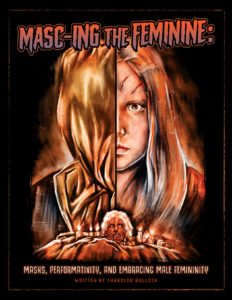
Slasher films have always had a profound relationship with feminine destruction. Plenty of discourse has been written on female characters under attack in slasher films, from women that make up the body count to the “final girls” that end up taking down the villain.. Not enough attention has been given to the killers themselves in this regard, though, and there’s an intriguing difference between the killers who speak and show their faces (i.e., Freddy and Chucky)and those who hide behind a mask. Most of these masked villains have obvious reasons as to why they cover their faces. Well, mostly. Jason is visibly deformed, and Ghostface is trying to stay anonymous. What about Leatherface, though? How about Michael Myers?
In a previous issue of We Are Horror, Nina Nesseth presented an outstanding analysis linking a killer’s mask to their sense of accountability. At the time that I pitched this article, I had not read Nina’s, but I think this is a fitting follow-up to it. However, I want to approach the act of hiding one’s face from the perspective of what these killers attack: femininity. To do this, I want to focus on a few specific masked killers and outline their relationship with feminine power, while linking these relationships to my own experiences in how “traditional” childrearing suppresses male femininity. For the sake of clarity, I’ll limit my focus to three characters that demonstrate three distinct relationships with femininity: Jason Voorhees, Michael Myers, and Leatherface. I’d like to start things off with an account of bullying and shame by looking at Jason Voorhees.
The hockey mask has become synonymous with the systematic slaughter of teenagers who dare to have a bit of flirtatious fun. Jason’s mask was one of the first images in horror to hold my imagination captive before ever even seeing the films. It terrified me to my core as a child. Like many fans, I was confused and a bit shocked when I initially saw the first two installments of the FRIDAY THE 13th franchise. Where was Jason? Who’s this lady? It was interesting to see that the whole story started as a tale of a mother still enacting vengeance for her son, long after he had died. Or so she thought, at least. It took me a while to truly appreciate the first film. I wanted the masked man promised to me. These days I find it to be one of the strongest films in the franchise. Though the film series would evolve into a pillar of slasher convention, its origins broke them down. We were presented with not just a woman as our killer, but also a mother. Pamela’s maternal drive to stamp out the evils that took her son away is the very foundation of the entire franchise. It also informs every film that follows it. This is made clear in FRIDAY THE 13th PART 2 (1981) when we meet Pamela’s baby boy for the first time. He’s all grown up and mad as hell. It’s never explained whether Pamela knew that Jason was alive, or if he had been watching from the woods this entire time. All that’s inferred is that he saw his mother die, and he wasn’t taking it very lightly.
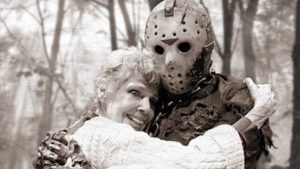
Confusion continues to abound in Part II for new viewers who’ve only ever seen the hockey mask because Jason is still not fitted with his trademark mask, even though his face is still hidden from the very start. Unlike most silent slashers, the Friday the 13th franchise does not leave Jason’s origins a mystery to explore in later installments. Instead, they are explored from the get-go, and continuously, throughout the film series. From the moment Ginny dresses up as Pamela, we see a softer side of Jason as he hesitates and practically cowers.
From the moment we see the shrine he’s made of her head to Ginny’s ruse, it’s clear that his relationship with his mother was quite powerful. Furthermore, the moment of his supposed drowning is shown in quite a few films throughout the franchise. What we’re always shown is a spindly, shy, and bullied boy with a facial deformity. His deformity changes in severity each time we see his face, but it’s always the mainstay. Kids are cruel. Jason being bullied for being different is an inevitability. It’s how adults handle the situation that matters the most at that point. What are the bullies being taught? How is Jason being supported? Based on what we see in the franchise, it seems that neither situation is handled much. Not beyond Pamela’s visceral love for Jason, anyway.
When we answer situations like this by saying that children need to “stand up for themselves”, to “toughen up”, and to “confront them”, we are demanding that they stop taking time to feel their emotions. Otherwise, all we are teaching them is to feel hate, both at those who wrong them and at themselves, as they are not being taught how to love who they are. Pamela is a protective mother who dearly loved her child, but her rage translates into Jason’s rage. She teaches him nothing but violence with her example. It appears that this is the way their family handles things: rage and brutality. Yet, the shame of his deformity remains. He recoils when he is first unmasked in each pre-zombified film. He was never taught to love himself or to explore his emotions, which is a common teaching in “masculinity”.
When he has his mask on, Jason is more able to enact the rage passed down from his mother. It allows him to live up to the ideal set from the beginning and so he fights back against the world, equating everyone in it to the bullies that made his childhood so hellish. Without the mask, while he doesn’t completely switch off, he becomes more sheepish and reflective. When his mask is removed, we get a literal and proverbial look at the young boy who died so many years ago. As someone who was bullied relentlessly as a child, I understand the rage that fuels a character like Jason. There’s a shame in being seen for who you truly are because you are told in all directions that who you are and how you feel aren’t “normal.” I can say, with experience, that wearing a mask helps to hide the shame. In the case of masked slashers, the mask also helps them take action against femininity, which they mistake as the source of their confusion and anguish.
In their confusion and shame, masked slashers often fixate on feminine sexuality while seeking to destroy it. Michael Myers demonstrates this well. Like Jason, Michael always seems to be stuck in the same mindset he had as a child. Granted, this reading mainly applies and will be limited to John Carpenter’s original depiction of Michael in HALLOWEEN (1978). He kills rather indiscriminately, but it’s in the way he kills that we can see how he is more fixated on feminine sexuality. For instance, when he kills Bob, it almost plays out like self-defense. Michael is hiding in the kitchen closet as Bob is getting some drinks. He only attacks once Bob finds him, as if he lashed out because he was spotted. I’ve always read this scene as either Michael fighting someone because he was spotted or as a twisted version of hide-and-seek. Much of Michael’s behavior resembles childlike pranks. Also notable is how quickly he disposes of Bob. He grabs, stabs, and then quietly inspects Bob’s lifeless body as a child might with a dead animal.
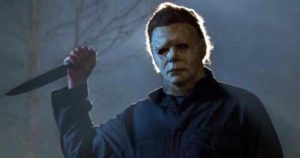
The girls are not given the same quick deaths, though. Both Annie and Linda are stalked and strangled. It’s important to note that the men killed in HALLOWEEN are both circumstantial situations, and both are stabbed to death. The truck driver likely approached Michael, as did Bob. Annie was chased down to be slowly murdered in a steamy car. Linda is strangled with a phone cable while topless. Laurie’s encounters with him are also quite physical. He’s unrelenting in his pursuit of her and uses his bare hands for the majority of the attack. Most striking to me has always been how his mask is linked to his violence. We see, from his own eyes, how he finds a mask outside before stalking and killing his sister at the beginning of the film. We see the same situation reversed when Laurie yanks the mask from his face later on. He recoils, looking like a scared and confused little boy. It’s evident from the truck driver’s fate that Michael can kill without a mask. Though, it seems to me that when face-to-face with a strong, willful woman, he needs the mask to even attempt to overpower her. He is made masculine in the face of femininity, but only when putting on his masculine face. Otherwise, he slinks away in shame and terror.
What is Michael so afraid of, though? We’re not given any tangible information about his upbringing. So, the only things we have to go by are his actions. He’s seemingly obsessed with his sister. From the casual murder to stealing her tombstone, he always seems to have Judith on his mind. I have often heard people chalk this up to him repressing a sexual attraction towards his sister. I don’t want to argue against that. Instead, I want to add to it, as I feel there is also a sense of jealousy in his actions. He lashes out and destroys women he finds attractive. In a sense, he claims ownership of them, but he is also jealous of the power they wield. They are sexually free and comfortable, whereas he is confused about his desires. I recognize this from my own experiences.
I have always had an appreciation of women’s fashion. Growing up, I was often misgendered as a girl, which, as I got older, went from being offensive to feeling like a badge of honor. It took me years to embrace my feminine traits, both physical and behavioral. In high school, I performed these traits freely. During this time, I was continuously told by peers and adults that I needed to be “more of a man” and was laughed at for my weaknesses–as opposed to being taught how to overcome them. Even my ex-partner of nearly 10 years pulled me in both directions by praising my feminine eye for fashion, while nearly gagging if I “looked too womanly”. I began to covet. I could be coded as a “straight man” in that I am male and I am attracted to women–although, I must admit that I have never thoroughly explored whether my attraction is limited to women. However, in my attraction, I have always felt a sort of jealousy and yearning to belong.
“Attraction” would imply that I merely love the sight of my idea of a beautiful woman, whereas I often find myself wishing I was as beautiful. As I have aged, I have coded myself more and more masculine. I grew out my beard and dressed in more masculine clothing (although the gendered aspect of clothing is an entirely different and contested issue for another discussion). It wasn’t until I rid myself of people who put me down, laughed at me, or simply made me feel worthless that I started to find myself again. The real me. I kept the beard, but I no longer feel the shame of desiring a fashion accessory labeled for women or wanting to wear makeup from time to time. In a sense, like Michael and Jason, I have systematically eradicated the sources in my life that have forced a gendered norm and ideal on me that simply did not fit. So, to answer the question, what could Michael have been so afraid of when stripped of his mask? In my view, he’s afraid of the unbridled power that comes with femininity. His masculine facade had been stripped away. His male femininity was exposed, but he had never known how to harness such an aspect of his being as well as a woman can.
This leads me to my final, but perhaps most complex, example in the form of Leatherface. Like with Michael, I will stick with the original depiction of the character as seen in THE TEXAS CHAIN SAW MASSACRE (1974). I know that this discussion has gotten fairly long, but I would be remiss discussing male femininity and masks without at least briefly exploring Leatherface’s use of them. Unlike Jason and Michael, Leatherface’s acts of violence don’t seem to come from repressed sexual urges. To quote the Faculty of Horror podcast, The Texas Chainsaw Massacre is very much an “asexual” film in that respect. Although he is shown to be quite confused throughout the film, it never appears that his confusion comes at all from within. Leatherface is quite a freely performative character. For one, he wears multiple masks instead of a single mask that defines his identity. He collects the faces of others and puts them on depending on how he feels at that moment. I won’t go too deeply into the complexities of how his identity seems to be linked to the literal faces of others, but I do want to briefly discuss how he uses these faces and what they say about his gender performativity.
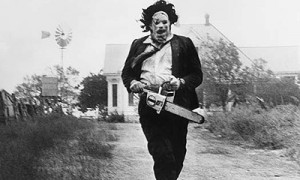
Leatherface seems to be a liminal figure that can seamlessly glide through gender norms based on the faces he wears. Notably, he is mostly shown wearing the faces of women when comfortably working at home. He has a face for when he is cooking, which leads him to mimic the behavior of a stereotypical housewife as his brothers drag Sally into the house; he has a face for dinner, which is that of a beautiful woman in makeup–though he makes sure to wear his best suit, rather than a dress; and, throughout most of the film, he even has a neutral, leathery face that seems to function as a working mask when he’s in the abattoir. Despite the mild quirks he displays with each mask, he is fairly consistent in his demeanor and feelings. He’s loyal to his family and protective of his household. Although he has a special mask for slaughtering and preparing meat, he doesn’t need it to ruthlessly attack those he deems either a threat or meat for the slaughter. He only seems to be conflicted by the verbal assaults Drayton pours out on him, which could account for his general, stunted empathy. Still, in terms of gender, the masks serve a much different function than they do for most slashers. I would even go as far as to say that Leatherface’s brand of violence combined with the function of his masks discounts him as a traditional “slasher”.
I was compelled to write this article, as I have grown to develop a strange fondness for these characters, based on their relationships with femininity. When I was a child, I was conflicted with the pressure to fulfill a gendered box presented to me, merely because I was a boy. I had my own interests and desires. I didn’t want to play football or build things with K’NEX. I wanted to write stories and have my own Easy-Bake Oven. I wondered why I couldn’t have a pink shirt when pink was my favorite color. Why did girls get to have fun hairstyles, but I had to keep it short so that people wouldn’t be confused? Why would people be confused? I was just me, after all. Growing up, my confusion turned to rage. My attire became darker. I alienated myself by being a downright little shit to others. If I couldn’t be myself, I wasn’t just going to sit by and let others have that luxury. Eventually, my only space of refuge from my daily struggles with being me was dressing up. Halloween and the stage allowed me to be whoever I wanted or needed to be at that time. I was a lot like Jason and Michael. A child stuck in rage, needing to wear masks–sometimes literally–to hide my shame and enact the behavior I thought those around me felt I should enact.
Now, in my thirties and supported by my loving girlfriend, I have found it easier to shed the need to fulfill the gendered limitations often thrust upon me. There’s still pain and anger. There’s still trauma brought on by various abuses I need to overcome. Though, I’m less destructive. Like Leatherface, I don’t need a mask to behave in a certain way, or to hide the beautiful feminine strength I’ve had all along. On the contrary, I love wearing masks, because they don’t hide me: they express me. I am learning to always be myself to the fullest with or without specific fashion–be it a mask or a nice top. I refuse to be strapped to the table of a gender binary or to live according to the gendered expectations of others. I still have a lot of searching to do as I try to understand who I, Chandler, really am. I can’t say with any certainty what I can be coded as. I don’t have a label. Perhaps I never will. Perhaps I won’t need one. The fact remains that when we push others into the slots we have assigned for them, there is always the danger of them pushing back.
It’s terrifying to see oneself in the masks of slashers. It’s tragic when you discover that, with a bit more open support and understanding from others, you could have removed the mask a long time ago. Still, I find masks comforting and freeing. Just as Leatherface uses masks to express rather than hide, I love to wear them to accessorize my already killer fashion sense. Stay safe. Wear a mask.

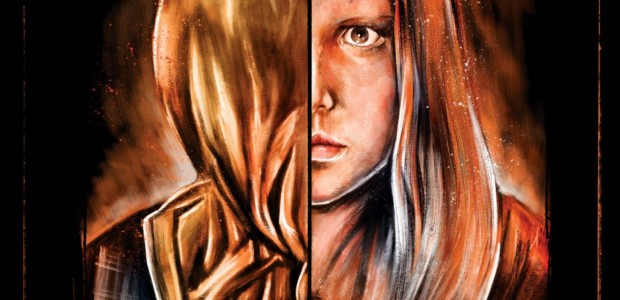
No Comments